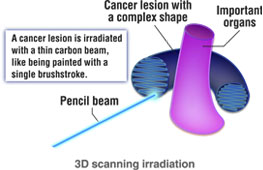
- Present status and actual results
- Future of heavy ion radiotherapy
Future of heavy ion radiotherapy
Aiming for more advanced therapy
Gunma University's heavy ion radiotherapy system for worldwide use, aiming to become a model for regional cancer therapy

Japan's newest heavy ion radiotherapy system, equipped with a compact medical accelerator for worldwide use, has been installed at Gunma University, where implementation of the therapy has been ongoing since 2010. This is Japan's third heavy ion radiotherapy system, following the National Institute of Radiological Sciences and the Hyogo Ion Beam Medical Center.
Moreover, this is the first heavy ion radiotherapy system to demonstrate the technology of a compact heavy ion beam irradiation system for worldwide use, for which the R&D was advanced mainly by the National Institute of Radiological Sciences. The building has two aboveground stories and one underground story, and the installation area is approximately 2,960 square meters (approximately 50 meters by 60 meters). This is a compact facility, and its size is less than half that of the cancer therapy system at the National Institute of Radiological Sciences (HIMAC).
This facility, which was constructed as a type for worldwide use, is expected to serve as a model when heavy ion beam irradiation facilities are installed in Japan's various regions in the future. Gunma University aims to construct a sophisticated general cancer therapy system for Gunma's medical care zones, effectively using this facility in cooperation with prefectural medical institutions.
Installation area of domestic heavy ion beam irradiation facilities in Japan
| Facility | Size | Proportion (%) |
|---|---|---|
| National Institute of Radiological Sciences (HIMAC) | 120 m × 65 m | 100 |
| Hyogo Ion Beam Medical Center | 95 m × 80 m | 96 |
| Gunma University Heavy Ion Medical Center | 60 m × 50 m | 38 |
Clinical research with a view to increasing indications of heavy ion radiotherapy
In addition, Gunma University is the first university in Japan to introduce a heavy ion radiotherapy system. Based on the ultramodern Gunma University Hospital, Gunma University aims to construct a complete general cancer therapy system with the provision of heavy ion radiotherapy.
Moreover, with the original advantages of being a university hospital, Gunma University can conduct clinical studies in which heavy ion radiotherapy is compared with other therapies, and applied research on concomitant therapies and so on. It is anticipated that Gunma University will advance clinical research, improving the results of cancer therapy by developing countermeasures for postoperative distant metastasis and by further elevating survival rates.
With the practical use of the heavy ion radiotherapy system for worldwide use, Gunma University is advancing original research to add minute cancers, pituitary tumors and other benign tumors, and cerebral vascular disease as indications of heavy ion radiotherapy, by developing high-accuracy carbon ion microsurgery techniques.
Scanning irradiation method

In May 2011, the NIRS started clinical testing on heavy ion radiotherapy using the 3D scanning irradiation method. In February 2016, Kanagawa Cancer Center (i-ROCK) started treating patients using this radiotherapy. This irradiation method involves applying a fine carbon beam to a cancer lesion that moves as the patient breathes, just like blotting out the area with a single stroke. The beam can be irradiated even to a lesion with a complicated shape, so the dosage to the lesion can be concentrated and side effects can be reduced. These advantages are expected to improve treatment results and quality of life.
Heavy ion rotating gantry
A rotating gantry is a system in which the irradiation device automatically moves and irradiates an appropriate beam to a patient lying on a treatment table. This is standard equipment at proton facilities. However, electromagnets with very large deflection are necessary for heavy ions because of their great mass. QST Hospital succeeded in reducing the equipment size by adopting superconducting magnets (heavy ion rotating gantry) and started using it for treatment from May 2017.
[Reference data] National Institutes for Quantum and Radiological Science and Technology, National Institute of Radiological Sciences, and Gunma University














